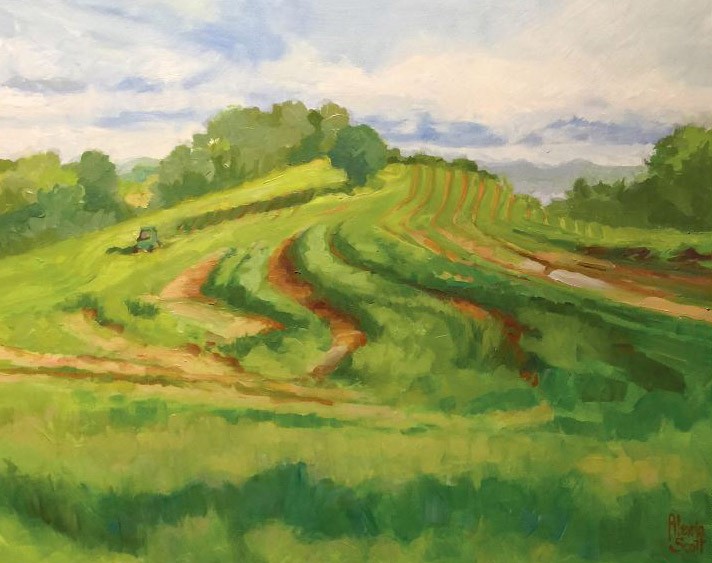I have been helping to mow our fields these last weeks of August, making long work out of what could be done by an experienced operator in a few days.
This mowing is far from Robert Frost’s contemplative whispering scythe, with which the poet kept his own fields just down the hill from ours some 100 years ago. No, our field is long past hay – if it was ever used for that – and is full of an array of wildflowers and brush and ferns. And there is nothing whispering about the tractor, which gives a baritone rev when I turn the key before it settles into a deep, mechanical purr. Where a scythe would clang resoundingly, I imagine, should its curved blade meet a boulder, the old bush hog instead grinds to a shuddering stop when I fail to avoid those brush-hidden chunks of granite left by the glaciers eons ago.
The truth is that I am a bit afraid of the big, green John Deere tractor, with its noises and levers and giant, churning wheels. But I am getting used to driving it. Despite still being a bit edgy behind the wheel as I bump along – sitting on the front edge of the seat to reach the tractor’s pedals – I have found that I like the distraction of mowing, the redrawing of the landscape little by little. While it is certainly not a quiet chore, I have found mowing can be a contemplative one.
The first day I mowed, as I nervously watched for rocks and endeavored to avoid overhanging branches, a rainbow arced across the sky at dusk to land behind the mountains. Another afternoon, the tractor, crawling noisily along, spooked two deer from where they must have been bedded down in the still-tall grass. They bounded away, down the hill and through the row of old apple trees, all lithe bodies and big eyes, their sleek pelts a deep amber in the summer sun.
As I trundle along, I am rediscovering the anatomy of our fields. I mow down to Big Rock, site of occasional picnic lunches; around the old burn pile, twined now with growing things; as near to the ancient, tumbling stone walls as I dare creep. I mow over rocks and around trees, through unseen ruts and across surprisingly muddy areas, where the tractor’s big wheels sometimes sink into the soft ground.
I’ve watched poor meadow voles scurrying away and leaping mice hurdling over freshly cut clumps of grass to flee the path of destruction. One day, I stopped to move an abandoned board left in the field and did some scurrying of my own, high-stepping back to the tractor to get away from the startled and writhing snakes I found beneath the wood. Probably they were garter snakes, but I didn’t stick around long enough to confirm their identity.
Little by little, I have mowed swaths through the tall, dead stalks of lupine that two months ago were filled with purple blooms and are now covered in seedpods dried to a mottled gray-brown. Mingling with these bygone flowers are lofty tufts of bright-yellow goldenrod and late-summer asters in white and purple, which I lament knocking down mid-bloom.
It is not all destruction, though. The patch of blueberry bushes, still producing, I have left untouched for now. Same with a section of blackberry brambles, whose fruits are just ripening. If we don’t get to picking them, surely the bears will. The other day, I stopped the tractor to break a section of pin cherry off so I could save a goldfinch nest – long abandoned at this point in the season – to admire its perfect cup and the birds’ method of affixing the nest to the tree with spiderweb silk.
With the destruction comes rejuvenation. Left unmown, the fields would revert to forest more quickly than it seems possible for trees to grow. In a section of the field that was not mowed last year, the pin cherry and willow saplings have grown bold and tall, requiring multiple passes with the bush hog to knock down. In another few years, these trees and others would align to block the view of the mountains, swallow the old apple orchard completely, change a habitat that has been – if not constant – similar for many decades.
So we mow, contributing to the cycle our fields have grown into: from winter snow to the dull hues of early spring, to knee-high then waist-high then shoulder-high growth, blooming into early autumn before being cut down to do it all again.
There is no whispering scythe here, but the fields hold poetry just the same.



Discussion *